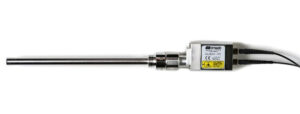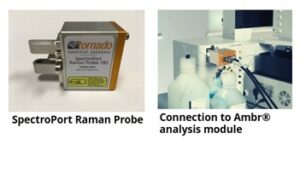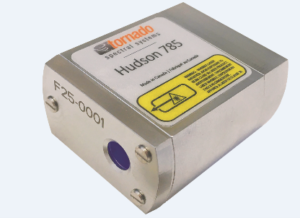Probe-Based Raman Spectroscopy
When chemists and spectroscopists want to measure molecules and molecular bonds in a chemical or biological sample, they may use Raman Spectroscopy, which uses laser light to observe changes in the vibrational energies of their chemical systems/samples.
Since the development of the first commercial Raman analyzer in 1953, there have been advances with lasers and detectors and the discovery of new phenomena have expanded the use of Raman in several fields such as pharmaceuticals and chemical manufacturing. But what about the Raman probe? There have been many advancements aimed at improving the sensitivity or resolution of the technique, and probe-based Raman is an enhancement that allows for optimal signal collection. In this blog, we highlight a newly released and versatile Raman probe while showcasing our advanced probes which are designed to get you even better and faster results for your Raman application.
Hudson™ Bioreactor Raman Immersion Probe

Hudson™ Bioreactor Raman Immersion Probe
Tornado’s Hudson™ Bioreactor Raman Immersion Probe enhances the power of Raman in bioprocess manufacturing by measuring multiple component concentrations and critical quality attributes (CQAs) in real-time for continuous, around-the-clock process feedback. There are many applications for process Raman applications in the “upstream” domain which require precise quantitative information, and this probe provides excellent data in both the fingerprint and CH-stretch regions, facilitating these demanding requirements. Advanced Raman probes like this one provide a perfect illustration of how fiber optics can be joined with other optical components to obtain a simple and flexible measurement.
At Tornado, we have extensive experience measuring the five core attributes most relevant to CHO cell fermentations: glucose concentration (nutrient), lactate concentration (metabolite that is an indicator of cell function), total cell count, viable cell count and protein titer. If your application has an important peak in the stretch band, the new Raman probe design provides approximately a factor of 2x signal boost (40% better SNR) over traditional probe devices. Combined with the 10x to 20x signal advantage of Tornado’s HTVS™ spectrometers, the total Tornado solution for upstream bioprocessing enables significantly smaller random errors in CQA measurements and greater confidence that your cultivation is proceeding as intended.
Each Hudson™ Raman immersion probe is connected to an excitation laser source and Raman analyzer by fiber optic cables. The probe’s rugged design and robust construction mean that it is suitable for a range of bioprocess applications, and the sapphire window is sealed without epoxy or gold, so extractables/leachables factors are no longer a concern. The wetted section of the Hudson™ Raman immersion probe is compatible with both autoclaving and gamma-radiation sterilization operations, providing the user with a fast and efficient tool for Raman analysis.
Overview:
- Construction uses only stainless steel and sapphire/glass, eliminating leachables concerns around epoxy or gold seals
- Can handle 1000 autoclave cycles (compared to 30-50 cycles for competing bioprobe products)
- Tube-in-tube design for reproducible reassembly after autoclaving, more robust and convenient y-axis calibration, and configurable focal offset (for turbid vs transparent media)
- Industry-standard PG13.5 fittings
Hudson™ 785 Non-Contact Raman Probe
Tornado’s Hudson™ 785 Non-Contact Raman Probe is a high-performance optical interface which enables even the most demanding process monitoring or lab applications. The Hudson™ 785 probe provides a powerful and flexible way to interface Tornado’s Raman spectrometers to many different types of samples and process equipment. It can be used for the superior representative sampling and measurement reproducibility for liquids, solids, slurries, powders, and heterogeneous mixtures.
Depending on specific user requirements, Tornado can configure the probe output for both laboratory and process applications, and users can quickly and easily swap the optics to match their specific needs. Typically we will discuss these details with the customer, find out details of which sample container or sample interface they are using and then we can make a recommendation on how to best optimize the signal collection for their specific application. We start with a standard design, and configure everything from there, ensuring you get exactly what you need to meet your requirements.
High-performance sampling for quantitative analysis
The probe head is optimized (étendue-matched) to the Tornado HTVS™ spectrometers, further boosting the throughput efficiency and measurement sensitivity. The interchangeable sample optics are tailored to the application which allow for superior representative sampling and reproducibility. A large-spot stand-off sampling is useful for powder blending, and feed frame and focused-spot stand-off sampling is meant for solids and transparent liquids. Users looking to improve analysis and performance logistics will note that the Hudson™ 785 uses robust single-core fiber optic cables (instead of fiber bundles) which can run long distances and be connected to a multiplexer. As a result, it is possible to amortize measurement costs by connecting multiple probes to a single analyzer.
RamanBioConnect™ Raman Probe – optimizing the upstream process for biopharma
The RamanBioConnect™ Raman Probe 785 is an accessory for use with Tornado’s HyperFlux™ PRO Plus 785 Raman spectrometer. It is specifically designed to connect to the Spectro™ optical spectroscopy interface originated by Sartorius Stedim Biotech (SSB) for their Ambr™ 15, Ambr™ 250, and Biostat STR® equipment. Its optical design allows for a small size to avoid taking up valuable lab space. Along with Tornado’s HyperFlux™ PRO Plus analyzer, the RamanBioConnect probe measures key process parameters and critical metabolites (i.e. glucose, glutamate, lactate, and others), making it the ideal solution for monitoring bioprocesses and cell cultures.
Complete integration between Tornado and Sartorius Systems

RamanBioConnect™ Raman Probe & Ambr™ module
- The Tornado Raman probe is designed specifically for the Sartorius BioPAT® Spectro port to provide maximum performance and reproducibility
- The probe measures the contents of the Ambr™ analytical module flow cell or pre-sterilized Flexsafe STR® single-use bag through a window in the integrated port. This removes the need for probe sterilization, reduces contamination risk and ensures high reproducibility
- A single Tornado PRO Plus can sample up to 8 Biostat STR® bioreactors, thereby increasing productivity and maximizing your ROI
Conclusion
Process Raman probes are used in a wide variety of industrial and laboratory environments, where they are sometimes subjected to extremes in temperature and pressure. For the highest quality Raman measurements, make sure that you’re using a probe with high collection efficiency, optimized optical filtering, and sufficient mechanical protection for the ambient environment. Taken together, these advancements have helped to maximize flexibility and performance and are proving to deliver sensitivity in a fraction of the time.
If you would like to discuss your application and are considering adopting Raman spectroscopy as a process analytic technology, please contact us at Sales.Tornado@bruker.com




